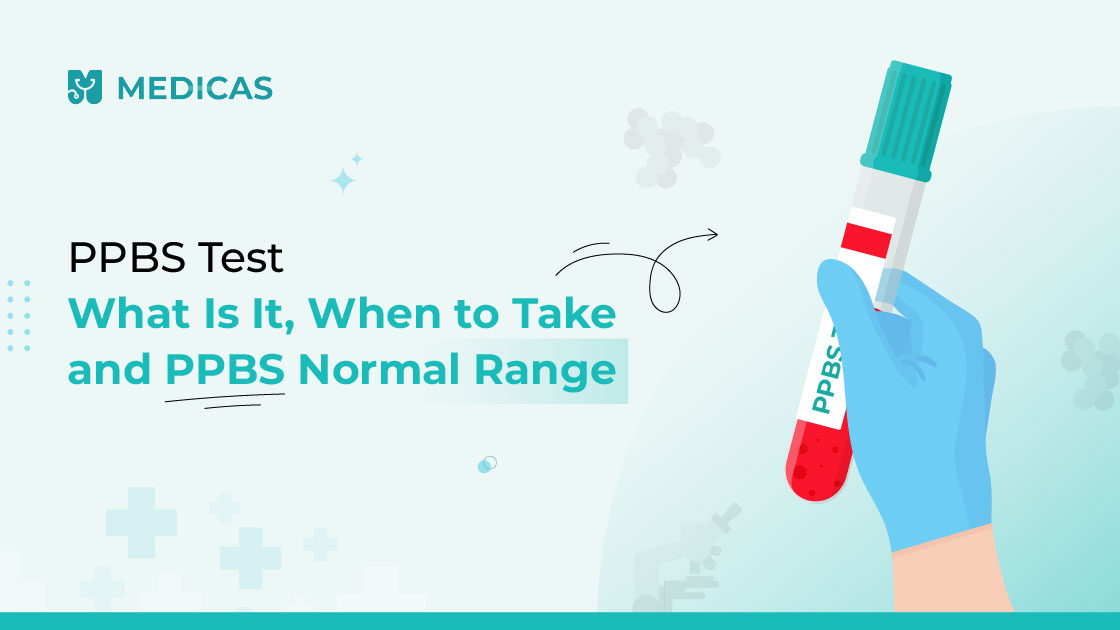Have you ever wondered how your body handles sugar after you eat? For many people, especially those with diabetes or at risk of developing it, this is a crucial question. Blood sugar levels can behave very differently before and after meals. That’s where the PPBS test comes in.
It is a common and essential diagnostic tool that helps measure how your body manages glucose after a meal. Whether you’re someone trying to manage diabetes or just being proactive about your health, understanding this test is a key step towards better well-being.
What is a PPBS Test?
PPBS Full Form in Medical Terms
The full form of PPBS is Postprandial Blood Sugar. The term “postprandial” comes from Latin, where “post” means after and “prandial” means meal. So, PPBS refers to the blood sugar level measured after eating a meal.
What Does PPBS Test Mean?
When you eat, carbohydrates are broken down into glucose and absorbed into the bloodstream. The PPBS test evaluates how effectively your pancreas secretes insulin and how well your cells use this glucose, crucial information for diagnosing and managing metabolic disorders.
Difference Between FBS and PPBS Tests
- FBS (Fasting Blood Sugar): Taken after an overnight fast of at least 8–10 hours.
- PPBS (Post Prandial Blood Sugar): Taken exactly two hours after a standard meal.
Comparing the FBS and PPBS normal ranges gives a fuller picture: FBS reflects your body’s baseline sugar control in a fasting state, while PPBS shows your body’s handling of real‑world eating patterns.
Also Read: A Comprehensive Guide on How to Test Blood Sugar at Home
Why is the PPBS Test Done?
Importance of Measuring Postprandial Blood Sugar
After we eat, our blood sugar levels naturally rise. However, in a healthy individual, insulin is released to help cells absorb the sugar, bringing levels back to normal. When this system fails, as in diabetes, sugar stays in the blood, potentially causing damage to organs over time.
Monitoring the PP blood sugar level is vital for:
- Diagnosing diabetes or prediabetes
- Evaluating the effectiveness of diabetic treatment
- Preventing complications such as nerve damage, kidney issues, and heart problems
Medical Conditions That Require a PPBS Test
A PPBS test is especially recommended for:
- People with type 1 or type 2 diabetes
- Pregnant women at risk of gestational diabetes
- Individuals with symptoms like frequent urination, fatigue, blurred vision
- Patients with borderline or abnormal FBS values
- Females with PCOS (polycystic ovary syndrome) as part of a metabolic assessment.
When and How is the PPBS Test Taken?
Timing of the 2-Hour PPBS Test
As the name suggests, the test is done exactly two hours after consuming a regular meal. This is because blood sugar typically peaks around this time after a meal.
The 2-hour PPBS normal range is the standard for interpreting results, ensuring consistency across individuals.
Guidelines to Prepare for the PPBS Test
- Eat your normal meal (do not overeat or undereat)
- Take your usual medications unless advised otherwise
- Avoid heavy physical activity post-meal
- Do not consume extra sugary items just before the test
This helps get a real-world snapshot of your usual blood sugar response.
Where to Get a PPBS Test Done (Online & Offline Options)
You can:
- Visit a nearby pathology lab or diagnostic centre.
- Opt for home sample collection through health platforms.
- Book a lab test online via platforms like Medicas.
Prefer comfort? Use an online doctor consultation to discuss your results from the comfort of your own home.
Also Read: Decoding Vital Insights: A Comprehensive Guide to Important Blood Tests
Understanding PPBS Normal Range
Normal PPBS Level for Non-Diabetics
For healthy individuals, the 2-hour PPBS normal range is typically below 140 mg/dL. Staying under this threshold indicates effective glucose clearance.
PPBS Normal Value for Diabetics
For those diagnosed with diabetes, the target PPBS normal range is typically below 180 mg/dL to minimise long‑term vascular damage.
Comparing FBS and PPBS Normal Range
| Test | Normal Range (Non-diabetic) | Diabetic Goal |
| FBS | 70–100 mg/dL | 80–130 mg/dL |
| PPBS | <140 mg/dL | <180 mg/dL |
Interpreting PP Blood Sugar Range
- <140 mg/dL: Normal response.
- 140–199 mg/dL: Impaired glucose tolerance (pre‑diabetes).
- ≥200 mg/dL: Diagnostic of diabetes if confirmed on a separate day.
For a more detailed interpretation of your test results and personalised guidance, you can reach out to me directly via Medicas.
PPBS Test Results and What They Mean
What If My PPBS is High?
A high PPBS level indicates that your body is struggling to manage the sugar from your meal. This could mean:
- Poor insulin response
- Insufficient medication
- Wrong dietary choices
Without correction, high PPBS accelerates atherosclerosis and can precipitate acute pancreatitis if extremely elevated.
What If My PPBS is Low?
Low PPBS is less common but can occur in:
- Over-medicated diabetics
- People with erratic eating habits
- Certain hormonal or liver conditions
Mild symptoms include dizziness, sweating, or confusion. Severe lows need immediate medical attention.
PPBS Blood Test: When to Repeat?
Your doctor may advise repeating the test:
- Monthly or quarterly (for diabetics)
- After treatment changes
- When symptoms arise
- During pregnancy.
Regular monitoring is key to good sugar control.
Also Read: Fasting Before a Blood Test: Everything You Need to Know
Managing Blood Sugar Post-Meal
Diet and Lifestyle Changes
- Eat fibre-rich meals to slow sugar absorption
- Avoid refined sugars and processed carbs
- Maintain a regular eating schedule
- Walk for 10-15 minutes after meals
- Follow a personalized diet plan created by a nutritionist.
Some home remedies, such as drinking fenugreek water, cinnamon tea, or consuming curry leaves, may also help in mild cases (consult your doctor first).
Tracking Normal Sugar Level PP Using Apps
Digital tools now make tracking sugar levels easy. Use mobile apps to:
- Log daily readings
- Set reminders
- Share data with your doctor
These apps can help you monitor your normal sugar levels, diet, exercise, and medication schedules seamlessly.
When to Seek Online Medical Help
If you consistently see PPBS levels above 200 mg/dL, or if symptoms such as extreme thirst, blurred vision, or persistent fatigue appear, don’t wait—book an appointment for a teleconsultation. Early intervention can prevent complications. You can also consult with me, directly via Medicas.
Conclusion
The PPBS test plays a critical role in monitoring and managing your blood sugar health. If you notice symptoms or are managing diabetes, don’t ignore the importance of post-meal sugar levels.
Want to check your PPBS without stepping out? You can book a lab test or book an appointment right from the comfort of your home with Medicas. Take care of your health, because early action saves lives.
Frequently Asked Questions
- How long should I wait after eating before taking a PPBS test?
You should take the PPBS test exactly 2 hours after starting your meal for accurate results.
- Can medication affect my PPBS test results?
Yes. Insulin or oral hypoglycemics can influence your PPBS levels. Always inform your doctor about your medications before testing.
- What does the full form indicate in diagnosis?
PPBS or Postprandial Blood Sugar helps diagnose how effectively your body manages sugar after meals, which is crucial for detecting diabetes or prediabetes.
- Is there an app or online tool to track my PP blood sugar range?
Yes! Many diabetes management apps are available to help you track your postprandial (PP) blood sugar range, monitor trends, and share data with your doctor.
Related Blogs
Disclaimer
Medical Advice: The information provided in this blog post is for educational purposes only and should not be considered as a substitute for professional medical advice, diagnosis, or treatment. Always consult with a qualified healthcare professional for personalized guidance regarding your specific medical condition.
Accuracy of Information: While we strive to provide accurate and up-to-date information, the field of medicine and viral fevers is constantly evolving. The content in this blog post may not reflect the most current research or medical guidelines. Therefore, it is advisable to cross-check any information provided with reliable sources or consult a healthcare professional.
Individual Variations: The symptoms, causes, treatment options, and preventive measures discussed in this blog post are general in nature and may not apply to everyone. It is important to remember that each individual’s situation is unique, and personalized medical advice should be sought when making healthcare decisions.
External Links: This blog post may contain links to external websites or resources for additional information. However, we do not endorse or have control over the content of these third-party websites. Accessing these links is done at your own risk, and we are not responsible for any consequences or damages that may arise from visiting these external sources.
Results May Vary: The effectiveness of treatment options or preventive measures mentioned in this blog post may vary from person to person. What works for one individual may not work the same way for another. It is essential to consult with a healthcare professional for personalized advice tailored to your specific needs.

Dr. Pratibha Shukla is a Diabetologist and Family Physician based in Mumbai, Maharashtra, with 8 years of clinical experience. She holds an MBBS, along with additional certifications including AFIH, PGDFM, CCEBDM, CCCS, and CCCMH, with a focus on diabetes care, family medicine, and occupational health. Dr. Shukla has worked with organizations such as ONGC, RCF Ltd., BARC Hospital, and under NHM programs, gaining experience in both clinical and community healthcare. Her expertise includes the management of diabetes, endocrine disorders, and chronic lifestyle diseases.


